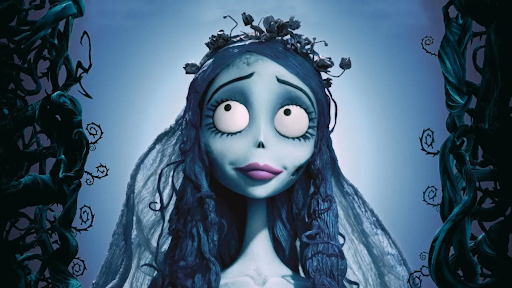Corpse Bride: A Timeless Halloween Classic
By William Budd, 3rd Year History
If you haven’t yet indulged in Tim Burton’s Corpse Bride, then beware… spoilers lie ahead.
On this day 20 years ago, Tim Burton’s Corpse Bride was released to British audiences, marking Burton’s stop-motion directing debut and following his production of The Nightmare Before Christmas ten years earlier. Here we explore the huge cultural significance of this masterpiece, using the music of the film to guide us through the story. Before you read this article, why don’t you go give it a watch? Don’t worry, I’ll still be here when you come back.
I’m sure that was a very enjoyable 77 minutes, and I hoped you watched it all, as you don’t want to miss a second of Danny Elfman’s masterful score. Accompanied by the main title, Corpse Bride opens with a montage depicting the mediocrity and despair of life in the town. With Burton’s trademark gloomy atmosphere, we soon become aware that a wedding is to take place. Yet, this gloom is swiftly juxtaposed with the introduction of Victor (Johnny Depp), our lovable yet slightly skittish protagonist, whom we first see freeing a butterfly trapped in a jar.
Victor from Corpse Bride (Image Credit: Warner Bros)
In ‘According to Plan’, we see two families obsessed with their social standing. William and Nell Van Dort, the fish merchant family, sing of forgetting everything you’ve ever been to attain new social standing, in their case through the marriage of their son Victor. This is contrasted with the seemingly affluent Everglot family’s despair at the marrying of their daughter Victoria to Victor, a man of lower social standing, in order to restore their wealth. As Victor journeys into the woods on the outskirts of the town to practice his wedding vows following a disastrous wedding rehearsal, he accidentally summons Emily (Helena Bonham-Carter), the titular Corpse Bride, from the underworld, as she drags him below to the Land of the Dead.
Emily from Corpse Bride (Image Credit: Warner Bros)
Victor wakes in a colourful vibrant pub, starkly contrasting with his gloomy life above ground. The most obvious difference though is that the patrons of this pub are all spirits of the dead, whether skeletons or otherwise. Following a brief exposition dump in the form of Bonejangles (Danny Elfman) and his Bone Boys fantastic jazzy performance, we begin to understand Emily more and the reason she was fated to marry Victor on that dark night in the woods. I find Emily’s attitude towards her own undead world one of the most interesting aspects of her character. She thinks of the Land of the Dead as dark and sad, describing it as the darkness in which she resides. In reality, Victor's world is far darker and more twisted, with those like Lord Barkis (Richard E. Grant) scheming and manipulating to his own end.
It is in this that we can see a deeper class discourse throughout the film. I see the relationship between the dead and the living as a wholly unique allegory for class interaction and conflict. Just like Victor and Victoria’s class differences are presented from the start, Emily and Victor really are worlds apart in how they understand their respective worlds, their view on life, and how ‘right’ they are for each other.
The film ends with the wedding ceremony of Victor and Emily, where the dead return to the world of the living to foil Lord Barkis’s masterplan. Although Emily struggles to imagine her husband marrying another woman, she understands that she has to let Victor go, so throwing her bridal bouquet to Victoria, his true love. She transforms into butterflies which soar towards the moon, as free as the butterfly released by Victor in the opening scene of the film. By marrying for love, he has released Emily to her own happiness - not marriage, but freedom from the underworld.
Corpse Bride is certainly a Halloween - and possibly even year-round - classic, and if you haven’t already revisited this Burton masterpiece this year, why not do so for its 20th anniversary?
Edited by Scarlett Bantin


